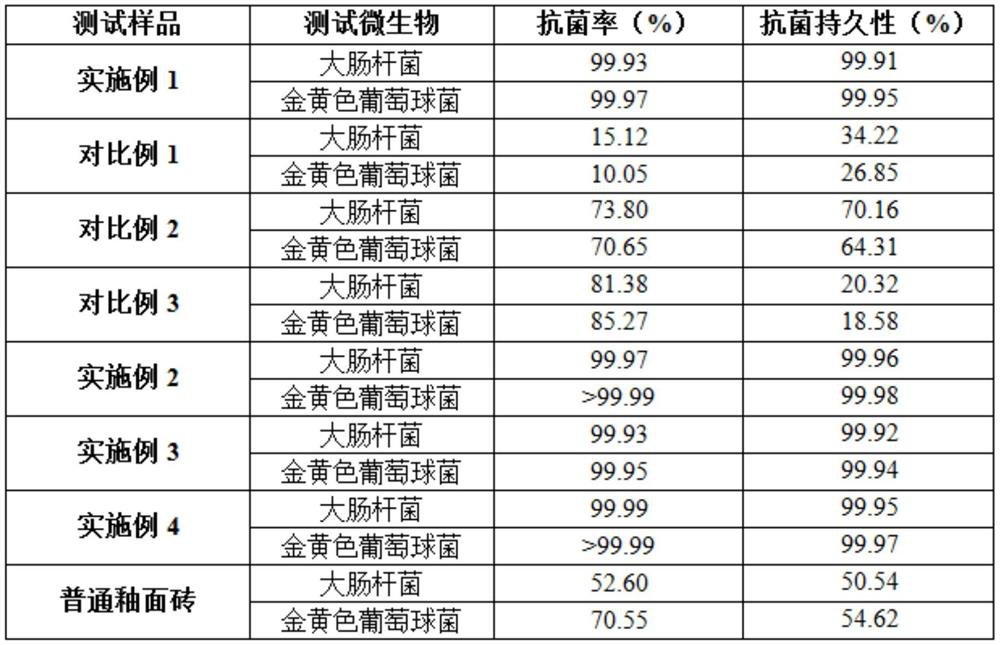A kind of production technology of antibacterial ceramic brick
A production process and technology of ceramic tiles, applied in the field of ceramic tiles, can solve problems such as poor antibacterial effect, inability to overflow antibacterial ions, and increased appearance defects on the surface of the glaze layer, and achieve long-lasting antibacterial and antifouling effects
- Summary
- Abstract
- Description
- Claims
- Application Information
AI Technical Summary
Problems solved by technology
Method used
Image
Examples
Embodiment 1
[0018] An antibacterial ceramic tile production process, which includes the following process steps:
[0019] 1) Preparation of nano antibacterial antifouling liquid: after mixing the nano zinc oxide with water evenly, add 1wt% HTK5040 dispersant for grinding and dispersion, control the solid content of 40wt%, the mass fraction of zinc ions is 4%, the average particle size is less than 200nm of the nano antibacterial paste, take the commercially available Planck A30 tile antifouling liquid and nano antibacterial slurry according to the proportion of raw material mass ratio of 100:5 to obtain nano antibacterial antifouling liquid;
[0020] 2) Use the polishing machine to polish the surface of the glazed tiles that have been fired, control the glaze gloss to 60 degrees, and after cleaning and blowing drying, the polished semi-finished products are obtained;
[0021] 3) Using abrasives, by waxing the nano antibacterial antifouling liquid obtained in step 1) brushing and squeezing ont...
Embodiment 2
[0037] An antibacterial ceramic tile production process, which includes the following process steps:
[0038] 1) Preparation of nano antibacterial antifouling liquid: the average pore size is 50 nm, the specific surface area is 60 m 2 / g Zirconium phosphate loaded with nano-silver and water after homogenization, adding 1.5wt% HTK5050 dispersion agent for grinding and dispersion, the control solid content of 10wt%, the mass fraction of silver ions is 2%, the average particle size is less than 200nm nano antibacterial paste, take the commercially available Guangdong Kening A228 antifouling liquid and nano antibacterial slurry according to the ratio of raw material mass to 100:30 mixing, to obtain nano antibacterial antifouling liquid;
[0039] 2) Use a polishing machine to polish the surface of the glazed tiles that have been fired into a type, control the glaze gloss of 65 degrees, and after cleaning and blowing drying, polish the semi-finished products;
[0040]3) Using abrasives,...
Embodiment 3
[0042] An antibacterial ceramic tile production process, which includes the following process steps:
[0043] 1) Preparation of nano antibacterial antifouling liquid: the average pore size is 80nm, and the specific surface area is 40m 2 / g diatomaceous earth was loaded with nano-zinc and mixed with water, 1.5wt% HTK5040 dispersant was added for grinding and dispersion, the control solid content was 20wt, the mass fraction of zinc ions was 20%, and the nano antibacterial slurry with an average particle size of less than 200nm was obtained, and the commercially available Guangdong Kejing A228 antifouling liquid and nano antibacterial slurry were mixed according to the ratio of raw material mass to 100:15 to obtain nano antibacterial antifouling liquid;
[0044] 2) Use a polishing machine to polish the surface of the glazed tiles that have been fired into a type, control the glaze gloss of 50 degrees, and after cleaning and blowing drying, polish the semi-finished products;
[0045] ...
PUM
| Property | Measurement | Unit |
|---|---|---|
| particle diameter | aaaaa | aaaaa |
Abstract
Description
Claims
Application Information
 Login to View More
Login to View More - R&D
- Intellectual Property
- Life Sciences
- Materials
- Tech Scout
- Unparalleled Data Quality
- Higher Quality Content
- 60% Fewer Hallucinations
Browse by: Latest US Patents, China's latest patents, Technical Efficacy Thesaurus, Application Domain, Technology Topic, Popular Technical Reports.
© 2025 PatSnap. All rights reserved.Legal|Privacy policy|Modern Slavery Act Transparency Statement|Sitemap|About US| Contact US: help@patsnap.com

